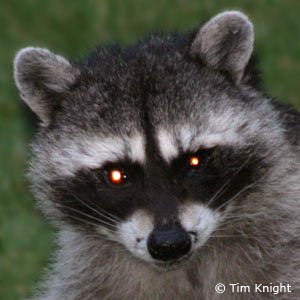
NatureMapping Animal Facts for Kids
Raccoon
|
Northern Raccoon (Procyon lotor)
Raccoons have a stocky build and typically weigh from six to seven kilograms (avg. 6 kg or 13.2 lbs). Males are usually heavier than females. The body length ranges from 603 to 950 mm (2 to 3 ft) 
Where they live:
Click the range map to learn more about the distribution of Raccoons in Washington. What they eat: Raccoons are omnivorous animals (they eat plants and animals). Plant foods vary from fruits to nuts, including wild grapes, cherries, apples, berries, and acorns. Raccoons may also eat peaches, plums, figs, citrus fruits, watermelons, and walnuts. They also forage for crayfish, insects, frogs, fish, and bird eggs. Raccoons have adapted to eat trash and other food available in urban areas. 
Behavior: Raccoons are nocturnal (active at night), but can sometimes be seen during daylight hours. They are solitary animals (live alone) and the only social group raccoons form consist of a mother and her young. Although they move slowly, with a shuffle like walk, they can reach speeds of 15 miles per hour on the ground. Raccoons climb with agility and are can withstand a drop of 35 feet from a tree. Raccoons are excellent climbers and strong swimmers. Reproduction: Raccoons mate between late January or early February. Lifespan/Longevity: Raccoons have been known to live a maximum of 16 years in the wild. A captive animal was recorded living for 21 years. The life span of raccoons in the wild is estimated at three to five years.
Did you know?
More information: Photo Credit: Tim Knight |
